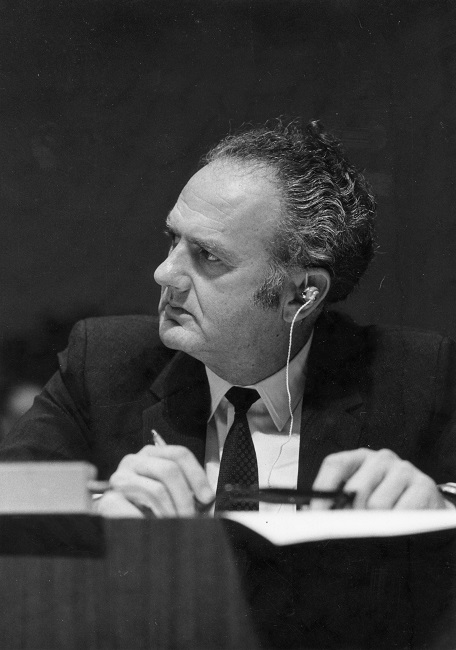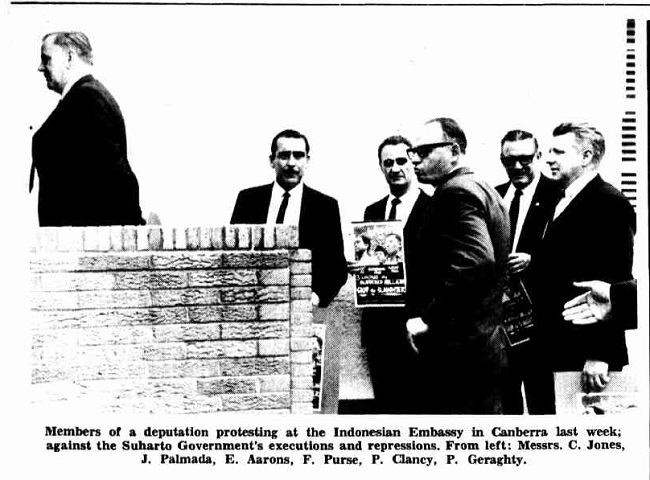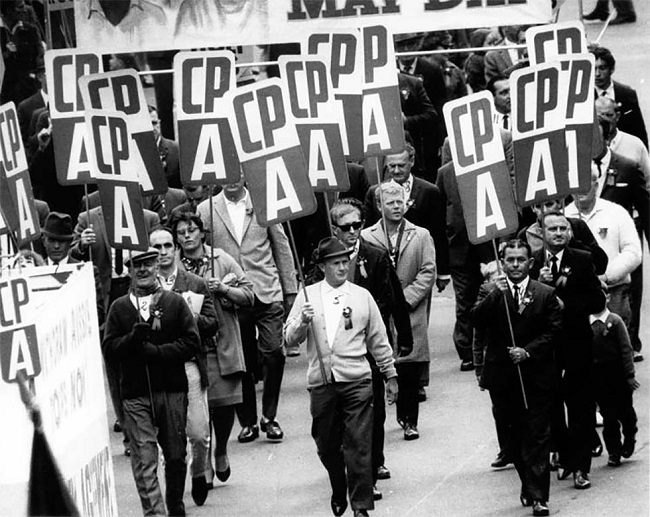The Australian Communist Party’s response to the anti-leftist violence in Indonesia
The Australian Communist Party’s response to the anti-leftist violence in Indonesia
Dominique Tasevski
This year marks one hundred years since the founding of the Communist Party of Australia (CPA) and the Communist Party of Indonesia (Partai Komunis Indonesia, PKI). During the height of Cold War tensions in Asia, strong ties emerged between these neighbouring organisations. From 1954 to 1965, four official CPA delegations visited Indonesia, all of which were hosted by the PKI; while the PKI deputy leader, Mohamed Lukman, travelled to Australia and was hosted by Laurie Aarons, the CPA’s leader from 1965 to 1976.
The CPA–PKI relationship was underpinned by a shared opposition to class-based and colonial oppression. Throughout the 1950s and early 1960s, the connections between the parties flourished due to shared anti-imperialist positions on regional political issues. Both organisations strongly supported Indonesia’s absorption of West Irian, opposed America’s military presence in the region, and resisted the federation of Malaysia.
Despite this, the CPA–PKI relationship was not immune to international Communist tensions. From 1956, the Communist superpowers, the Soviet Union and China, became embroiled in tensions known as the Sino-Soviet dispute. By 1964, the ties between the CPA and the PKI quickly deteriorated as the Sino-Soviet dispute reverberated across the region. The two parties sided with opposing Communist superpowers as the CPA backed Moscow and the PKI supported Beijing. Within this context, the PKI ostracised its former Australian comrades by prioritising its loyalty to Beijing over the longstanding relationship with its neighbouring party.
Aarons spearheaded attempts by the CPA to salvage the CPA–PKI relationship. But these efforts were to no avail as the PKI continued to shun the Australian party. However, the lack of a CPA–PKI reconciliation did not influence the Australian party’s reaction to the outbreak of violence in Indonesia in 1965. In fact, it was the CPA that led the Australian political resistance to the persecution of the Indonesian left wing.
Responding to the purges
From October 1965 until mid 1966, the Indonesian army, anti-Communist militias, Islamic organisations and civilians killed approximately 500 000 to one million Indonesians due to their real or perceived association with the Indonesian left. In the following years, approximately 750 000 people were also detained, some for up to 20 years, due to their alleged links with the left. Within a few months, the CPA’s nearest neighbouring party and the largest non-governing Communist party in the world, was destroyed.

Due to Cold War concerns about Sukarno and the PKI, the Australian government was unperturbed by the killings of hundreds of thousands of civilians due to their perceived or actual affiliation with the left. The Australian Opposition Leader, Arthur Calwell, dismissed concerns about the violence by asserting that it was an ‘internal matter’ which would be appropriately ‘dealt with’ by the Indonesian people. In 1966, members of the Australian government expressed their relief that Indonesia would not succumb to Communism and praised the ‘spring cleaning campaign’ against the PKI. That year, the New York Times reported that the Australian Prime Minister Harold Holt had gleefully stated that ‘with 500 000 to one million Communist sympathisers knocked off, I think it’s safe to say a reorientation had taken place’.
Despite the tension in the CPA–PKI relationship, the CPA was horrified by the killings of its Indonesian comrades. From October 1965 until 1968, the party led the Australian political opposition to the violence and used a variety of methods to protest against the oppression of the Indonesian left wing.
The party used its newspaper, Tribune, as a medium to resist the violence and demonstrate solidarity with its Indonesian comrades. From October 1965 onwards, Tribune published hundreds of articles about the violence which also expressed solidarity with the PKI. Tribune reports argued that right-wing military figures were behind the G30S incident rather than PKI-linked officers, and strongly condemned the Australian media for espousing pro-military views and supporting the killings.
Unlike the mainstream Australian media, Tribune emphasised the severity of the violence. Just two months after the G30S incident, Laurie Aarons, the new CPA leader who had visited Indonesia and established personal friendships with PKI leaders including its Chairman DN Aidit, wrote that the violence in Indonesia had ‘all the trimmings of arson, murder, pillage and repression’.
The CPA’s concern about the violence can be directly contrasted with the aforementioned position of the Australian government and the ambivalence of the Australian Opposition Leader. As party leader, Aarons directed the CPA’s attention to the violence in Indonesia and was a leading voice of protest due to the connections he had established with PKI leaders. Throughout 1965, the CPA primarily used Tribune to protest against the violence.
Direct approach
From 1966, the CPA diversified its methods of protest against the Indonesian military as attempts by members of Indonesia’s armed forces to seize power from Sukarno became more evident. The party began to send cables to the Indonesian government, including to Sukarno, protesting against the killings and death sentences imposed on the few PKI leaders who were tried.
The CPA also used the execution of PKI leaders who had links with Australia to encourage acts of protests from individual party members. The May 1966 execution of Mohamed Lukman, the PKI’s Deputy Chairman, who visited Australia in 1963 as a guest of Aarons, was used to rally further activism. Aarons urged CPA members to protest strongly to the Indonesian Ambassador against the ‘continuing slaughter’. Aarons’s requests ultimately appeared to trigger reactions from the CPA membership as CPA branches sent letters to the Indonesian ambassador describing their horror at the violence and the mass incarceration of civilians.
The party directly lobbied Suharto to end his campaign of violence against the left. In July 1966, the CPA sent a cable to Suharto, the then Defence Minister, which urged him to stop persecuting the left. During 1967, the CPA held public meetings about Indonesia and passed party resolutions demanding an end to the violence.
The events of 1968 constituted an unprecedented level of activism from the CPA. That year, the party significantly intensified its activism and adopted new methods of protest. Aarons spearheaded these efforts, which the CPA labelled as an appeal, as he was distraught by the destruction of the PKI and believed that a widespread campaign was needed to support the political prisoners. The CPA and its affiliated unions consequently began to intensify their protests. In July, Aarons sent a letter to sympathetic unions informing them of new information about the repression in Indonesia. In the context of these demands, Tribune reported that at least seven branches of industrial unions had issued resolutions condemning the mistreatment of political prisoners. The CPA’s newspaper linked this union activism with the earlier letter from Aarons urging protests.
The CPA also distributed letters to its membership urging party supporters to protest against the mistreatment of political prisoners. In September 1968, Aarons publicly announced the CPA’s appeal demanding an end to the persecution and inhuman treatment of Indonesian political prisoners. This appeal involved the distribution of 300 copies of the aforementioned letter to Australian federal and state politicians, unions, student organisations and academics.
According to Tribune reports, the majority of parliamentarians and unionists responded favourably to the appeal, which triggered reactions from other political organisations. State parliamentarians sent a petition to the Indonesian ambassador protesting against the continued repression in Indonesia. Trade unions also increased their efforts and sent letters to the United Nations and the Indonesian Embassy.
The party continued to directly lobby President Suharto. In 1968, Aarons sent a cable to Suharto urging clemency for five PKI leaders, Sudisman, Njono, Sjam, Supadrio and Martono, who had been sentenced to death due to their purported involvement in the G30S. The CPA wrote a letter to the Indonesian ambassador demanding clemency for the five men. Aarons subsequently began to disseminate a petition in Sydney requesting clemency, which received over 500 signatures. However, by the end of October, PKI politburo members Sudisman and Njono were executed.
Public protest
The deaths of Sudisman and Njono prompted a new form of activism from the CPA. The party mass-produced a poster, which depicted Aidit, Sudisman and Njoto, and was displayed in public spaces throughout Sydney. It highlighted the scale of the violence by stating that the men were ‘three among the murdered million’ Indonesians. This poster was also used by the party in other acts of protest.

In November 1968, the CPA’s Indonesia appeal culminated in a demonstration at the Indonesian Embassy. In Canberra, a joint CPA – trade union delegation conducted a protest at the Indonesian Embassy over the killings and mistreatment of political prisoners. The CPA delegation presented their petition to Indonesian diplomats, in addition to a letter condemning the killings and incarceration of Indonesian communists, unionists and women’s activists.
With the deaths of Sudisman and Njono, a majority of the PKI Politburo members had been killed. As such, the CPA’s protests were ineffective in altering the Suharto regime’s oppressive policies towards the Indonesian left wing. By 1969, the CPA’s activism on behalf of leftists progressively waned. The CPA’s attention moved towards the situation in West Irian and the party focused its regional attention on the Vietnam war.
Nonetheless, the CPA led the Australian political opposition to the violence against the left in Indonesia from 1965 to 1968. Under the leadership of Laurie Aarons, the party used a variety of methods to protest against the violence. While the CPA’s activism was ineffective in changing the behaviour of the Suharto regime, it occurred amidst little other protest in Australia and the West more broadly. The CPA’s stance can be contrasted with the position of the Australian government, which actively supported the killings and decimation of the PKI, and the ambivalence of the Australian opposition. The CPA was therefore one of the few Australian political organisations to vehemently and publicly oppose the repression of the Indonesian left wing.
Dominique Tasevski completed her Bachelor of Arts (Honours) at the University of Melbourne. Her thesis, Comrades in Arms?: The Relationship between the Australian and Indonesian Communist Parties from 1954-68, was awarded the Brian Fitzpatrick Prize for Best Honours Thesis in Australian History. Dominique specialises in Indonesian history and politics.












